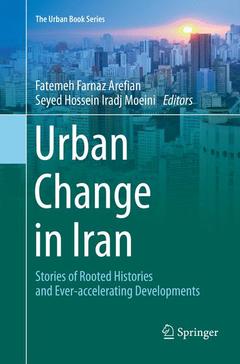Urban Change in Iran, 1st ed. 2016 Stories of Rooted Histories and Ever-accelerating Developments The Urban Book Series
Coordonnateurs : Arefian Fatemeh Farnaz, Moeini Seyed Hossein Iradj

This book, based on conference excerpts, investigates various aspects of contemporary Iranian urbanism. The topics covered range from the impacts of political developments on the cities? rapid socio-economic developments, to the cities? troubled relationship with the country?s built-environment history and their frequently ill-managed exposure to Western notions of development and globalisation. Last but not least, the country?s vulnerability to natural disasters in an age of increasing urban-population densification is also considered.
Alongside more theoretically and artistically oriented debates, the book?s individual contributions turn their attention to the now much higher proportion of urban dwellers in the country?s rising population. It also discusses the policies designed in response to these demographic moves, including those to develop new towns, find housing for the excess population in existing cities, renovate historic buildings and create new public spaces. The practice-policy oriented contributions also include those concerning the country?s responses to natural disasters.
1. Introduction.- Part I: Pre-modern and Contemporary Urbanism.- 2. The Role of Qanat and Irrigation Networks in the Process of City Formation and Evolution in the Central Plateau of Iran, the Case of Sabzevar.-3. In the Shadow of Written History: An Exploration of the Tehran Bazaar as a Non-Place.- 4. Re-visiting Three Neighbourhoods of Modern Tehran: Chaharsad-Dastgah, Narmak and Nazi-Abad.- 5. A review of Urban Images of Tehran in the Iranian Post-revolution Cinema.- Part II: Contemporary Society and Culture.- 6.From Modesty to Immodesty: A Quranic Reading of Change in the Islamic Iranian City.- 7. Tehran: a Call for Spatial Justice.- 8. Citizens as Drivers for Urban Change: Citizens’ Exhibition as Par-ticipatory Tool. The Case of Hashtgerd New Town.- Part III: Urban Continuity or Discontinuity.- 9. Tehran, the Scene of Modernity in the Pahlavi Dynasty: Modernisa-tion and Urbanisation Processes 1925 – 1979.- 10. From Utopia to Dystopia: Shushtar-e-no Endeavour Towards Par-adigmatic Shift.- 11. Tehran and the Lost Nature.- Part IV: Shaping Iranian Cities (zooming out).- 12. The Relationship between Urban Governance and Sustainable Urban Development in Iran.- 13. Tehran: Old and Emerging Spatial Divides.- 14. Typo-Morphological Analysis of Housing Layout and Density in Tehran.- Part V: Shaping Iranian Cities (zooming in): Urban Projects and Programmes.- 15. The Effects of Iran’s First Baby Boomers (1976––1986) on the Housing Economy of Iran and the Government Policies to Deal with its Resulting Issues.- 16. The Evaluation of State Involvement in Large-scale Property-led Regeneration Projects in Iran.- 17. Getting Ready for Urban Reconstruction: Organising Urban Housing Reconstruction in Bam.
Date de parution : 03-2019
Ouvrage de 256 p.
15.5x23.5 cm
Date de parution : 12-2015
Ouvrage de 256 p.
15.5x23.5 cm
